Nursing Case Study: Dementia Patient Assessment and Treatment
VerifiedAdded on 2022/09/17
|12
|3233
|28
Case Study
AI Summary
This case study presents a comprehensive analysis of an 81-year-old patient, referred to as Patient A, diagnosed with dementia. The assignment details the patient's history, presenting symptoms like memory loss, aggression, and confusion, alongside relevant vital signs and diagnostic findings, including cognitive and physical examinations. It explores the diagnosis of dementia, supported by evidence-based literature, and outlines treatment approaches such as supportive therapies, medication, and environmental modifications. The core of the study focuses on nursing interventions, emphasizing the importance of assessing cognitive function, addressing chronic confusion, and managing communication difficulties. Furthermore, the assignment provides a critical analysis of the patient's health background, risk factors, epidemiological data, etiology, anatomy, and pathophysiology of dementia, supported by numerous scholarly references. The study integrates social, ethical, and legal aspects relevant to dementia care, providing a detailed overview of patient management and care.

Running head: NURSING ASSIGNMENT
NURSING ASSIGNMENT
Name of the student:
Name of the university:
Author note:
NURSING ASSIGNMENT
Name of the student:
Name of the university:
Author note:
Paraphrase This Document
Need a fresh take? Get an instant paraphrase of this document with our AI Paraphraser
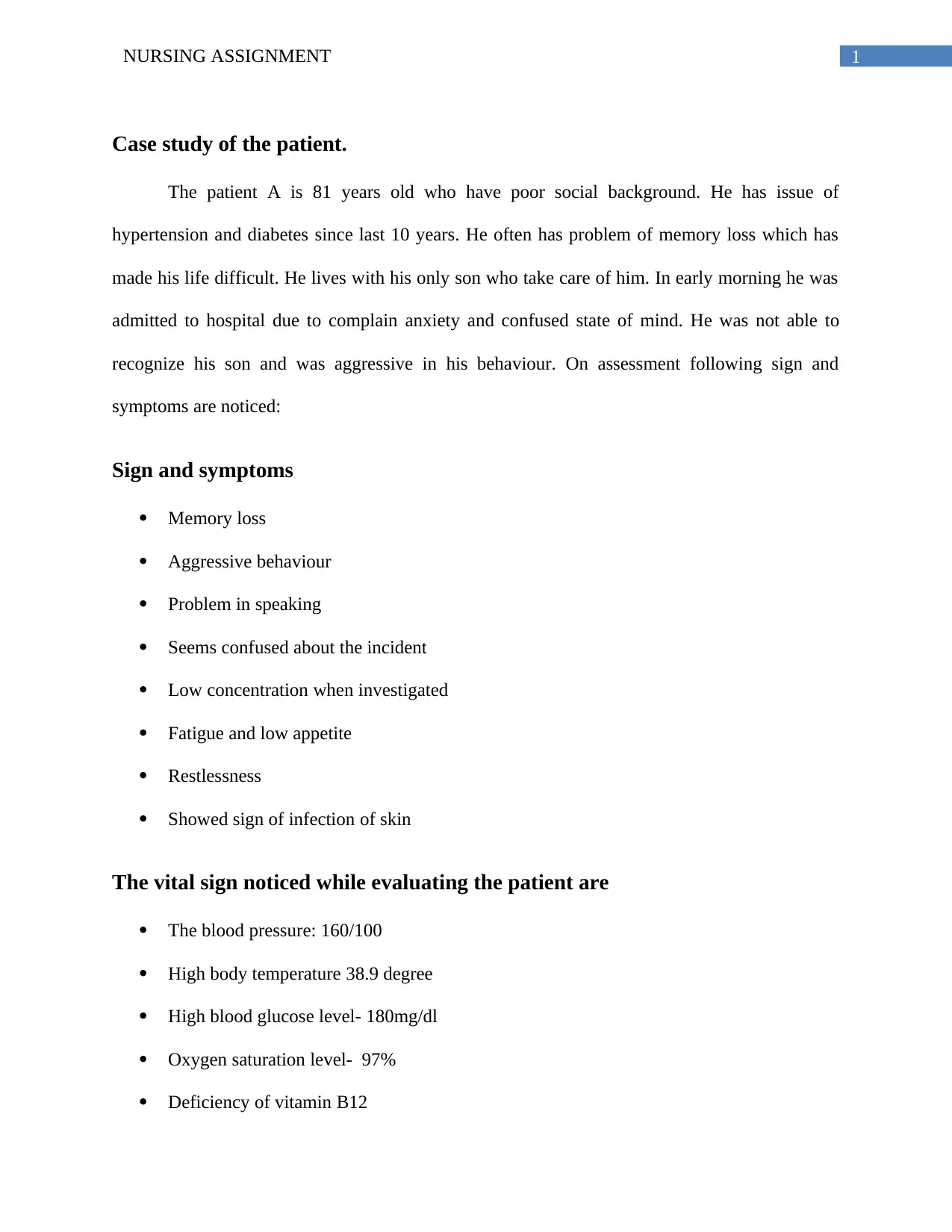
1NURSING ASSIGNMENT
Case study of the patient.
The patient A is 81 years old who have poor social background. He has issue of
hypertension and diabetes since last 10 years. He often has problem of memory loss which has
made his life difficult. He lives with his only son who take care of him. In early morning he was
admitted to hospital due to complain anxiety and confused state of mind. He was not able to
recognize his son and was aggressive in his behaviour. On assessment following sign and
symptoms are noticed:
Sign and symptoms
Memory loss
Aggressive behaviour
Problem in speaking
Seems confused about the incident
Low concentration when investigated
Fatigue and low appetite
Restlessness
Showed sign of infection of skin
The vital sign noticed while evaluating the patient are
The blood pressure: 160/100
High body temperature 38.9 degree
High blood glucose level- 180mg/dl
Oxygen saturation level- 97%
Deficiency of vitamin B12
Case study of the patient.
The patient A is 81 years old who have poor social background. He has issue of
hypertension and diabetes since last 10 years. He often has problem of memory loss which has
made his life difficult. He lives with his only son who take care of him. In early morning he was
admitted to hospital due to complain anxiety and confused state of mind. He was not able to
recognize his son and was aggressive in his behaviour. On assessment following sign and
symptoms are noticed:
Sign and symptoms
Memory loss
Aggressive behaviour
Problem in speaking
Seems confused about the incident
Low concentration when investigated
Fatigue and low appetite
Restlessness
Showed sign of infection of skin
The vital sign noticed while evaluating the patient are
The blood pressure: 160/100
High body temperature 38.9 degree
High blood glucose level- 180mg/dl
Oxygen saturation level- 97%
Deficiency of vitamin B12
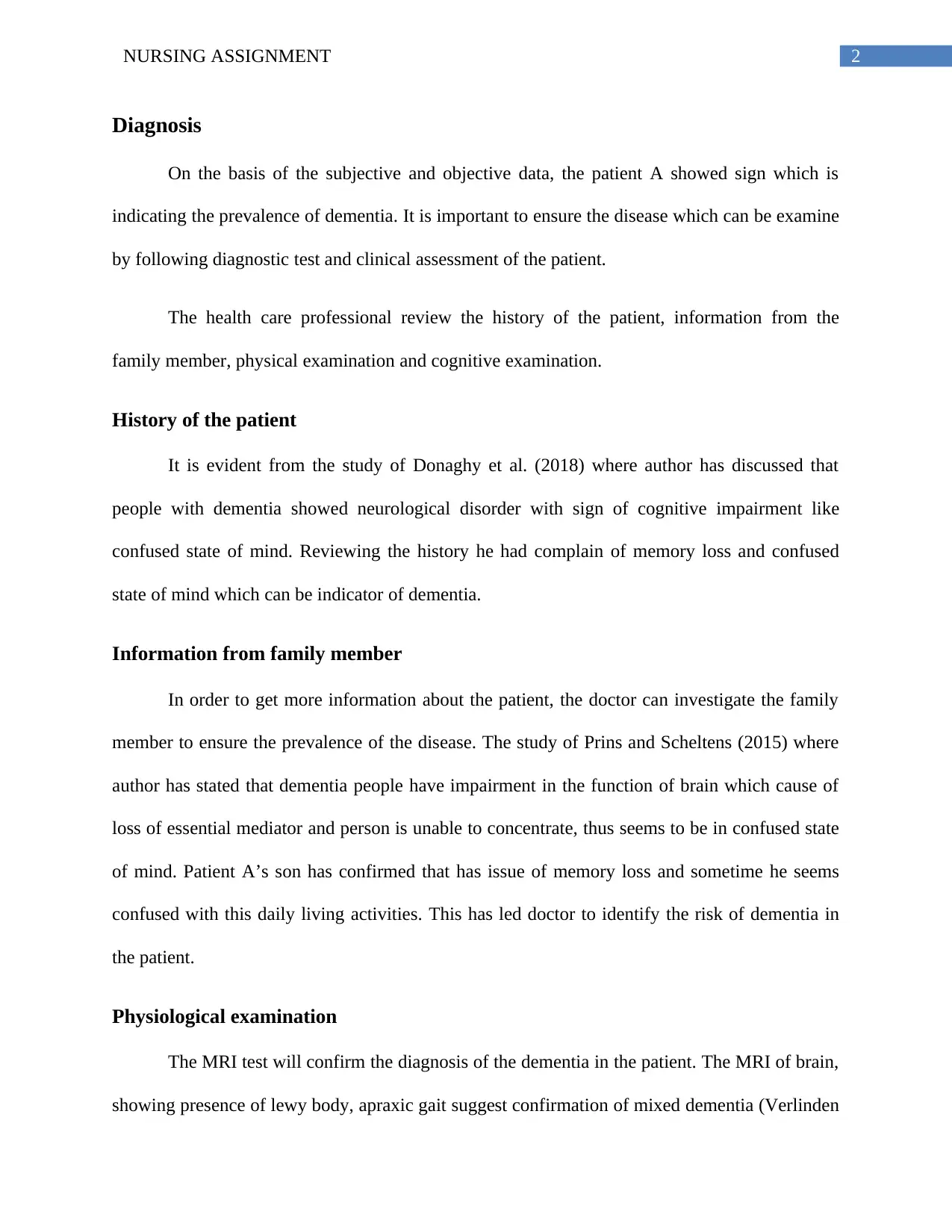
2NURSING ASSIGNMENT
Diagnosis
On the basis of the subjective and objective data, the patient A showed sign which is
indicating the prevalence of dementia. It is important to ensure the disease which can be examine
by following diagnostic test and clinical assessment of the patient.
The health care professional review the history of the patient, information from the
family member, physical examination and cognitive examination.
History of the patient
It is evident from the study of Donaghy et al. (2018) where author has discussed that
people with dementia showed neurological disorder with sign of cognitive impairment like
confused state of mind. Reviewing the history he had complain of memory loss and confused
state of mind which can be indicator of dementia.
Information from family member
In order to get more information about the patient, the doctor can investigate the family
member to ensure the prevalence of the disease. The study of Prins and Scheltens (2015) where
author has stated that dementia people have impairment in the function of brain which cause of
loss of essential mediator and person is unable to concentrate, thus seems to be in confused state
of mind. Patient A’s son has confirmed that has issue of memory loss and sometime he seems
confused with this daily living activities. This has led doctor to identify the risk of dementia in
the patient.
Physiological examination
The MRI test will confirm the diagnosis of the dementia in the patient. The MRI of brain,
showing presence of lewy body, apraxic gait suggest confirmation of mixed dementia (Verlinden
Diagnosis
On the basis of the subjective and objective data, the patient A showed sign which is
indicating the prevalence of dementia. It is important to ensure the disease which can be examine
by following diagnostic test and clinical assessment of the patient.
The health care professional review the history of the patient, information from the
family member, physical examination and cognitive examination.
History of the patient
It is evident from the study of Donaghy et al. (2018) where author has discussed that
people with dementia showed neurological disorder with sign of cognitive impairment like
confused state of mind. Reviewing the history he had complain of memory loss and confused
state of mind which can be indicator of dementia.
Information from family member
In order to get more information about the patient, the doctor can investigate the family
member to ensure the prevalence of the disease. The study of Prins and Scheltens (2015) where
author has stated that dementia people have impairment in the function of brain which cause of
loss of essential mediator and person is unable to concentrate, thus seems to be in confused state
of mind. Patient A’s son has confirmed that has issue of memory loss and sometime he seems
confused with this daily living activities. This has led doctor to identify the risk of dementia in
the patient.
Physiological examination
The MRI test will confirm the diagnosis of the dementia in the patient. The MRI of brain,
showing presence of lewy body, apraxic gait suggest confirmation of mixed dementia (Verlinden
⊘ This is a preview!⊘
Do you want full access?
Subscribe today to unlock all pages.

Trusted by 1+ million students worldwide
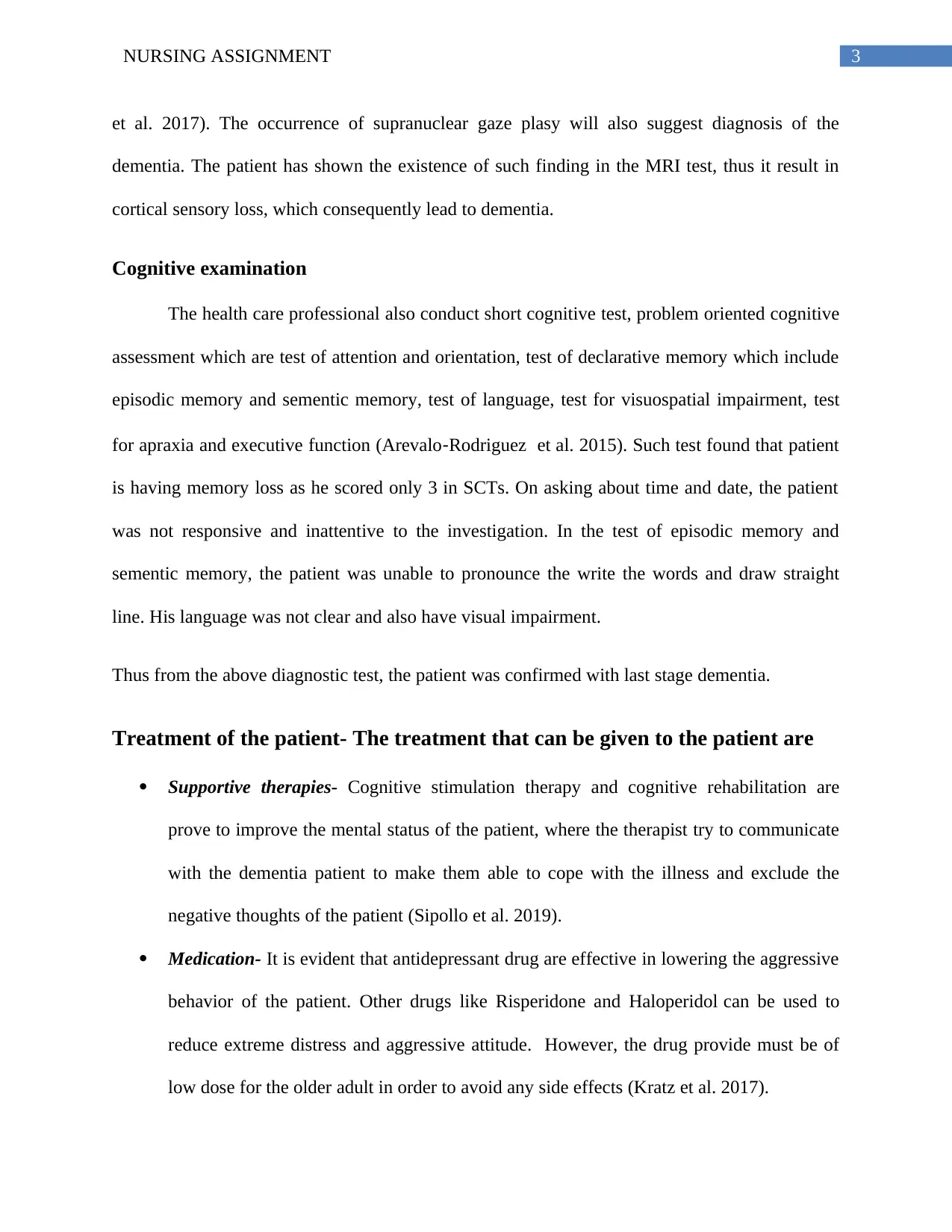
3NURSING ASSIGNMENT
et al. 2017). The occurrence of supranuclear gaze plasy will also suggest diagnosis of the
dementia. The patient has shown the existence of such finding in the MRI test, thus it result in
cortical sensory loss, which consequently lead to dementia.
Cognitive examination
The health care professional also conduct short cognitive test, problem oriented cognitive
assessment which are test of attention and orientation, test of declarative memory which include
episodic memory and sementic memory, test of language, test for visuospatial impairment, test
for apraxia and executive function (Arevalo‐Rodriguez et al. 2015). Such test found that patient
is having memory loss as he scored only 3 in SCTs. On asking about time and date, the patient
was not responsive and inattentive to the investigation. In the test of episodic memory and
sementic memory, the patient was unable to pronounce the write the words and draw straight
line. His language was not clear and also have visual impairment.
Thus from the above diagnostic test, the patient was confirmed with last stage dementia.
Treatment of the patient- The treatment that can be given to the patient are
Supportive therapies- Cognitive stimulation therapy and cognitive rehabilitation are
prove to improve the mental status of the patient, where the therapist try to communicate
with the dementia patient to make them able to cope with the illness and exclude the
negative thoughts of the patient (Sipollo et al. 2019).
Medication- It is evident that antidepressant drug are effective in lowering the aggressive
behavior of the patient. Other drugs like Risperidone and Haloperidol can be used to
reduce extreme distress and aggressive attitude. However, the drug provide must be of
low dose for the older adult in order to avoid any side effects (Kratz et al. 2017).
et al. 2017). The occurrence of supranuclear gaze plasy will also suggest diagnosis of the
dementia. The patient has shown the existence of such finding in the MRI test, thus it result in
cortical sensory loss, which consequently lead to dementia.
Cognitive examination
The health care professional also conduct short cognitive test, problem oriented cognitive
assessment which are test of attention and orientation, test of declarative memory which include
episodic memory and sementic memory, test of language, test for visuospatial impairment, test
for apraxia and executive function (Arevalo‐Rodriguez et al. 2015). Such test found that patient
is having memory loss as he scored only 3 in SCTs. On asking about time and date, the patient
was not responsive and inattentive to the investigation. In the test of episodic memory and
sementic memory, the patient was unable to pronounce the write the words and draw straight
line. His language was not clear and also have visual impairment.
Thus from the above diagnostic test, the patient was confirmed with last stage dementia.
Treatment of the patient- The treatment that can be given to the patient are
Supportive therapies- Cognitive stimulation therapy and cognitive rehabilitation are
prove to improve the mental status of the patient, where the therapist try to communicate
with the dementia patient to make them able to cope with the illness and exclude the
negative thoughts of the patient (Sipollo et al. 2019).
Medication- It is evident that antidepressant drug are effective in lowering the aggressive
behavior of the patient. Other drugs like Risperidone and Haloperidol can be used to
reduce extreme distress and aggressive attitude. However, the drug provide must be of
low dose for the older adult in order to avoid any side effects (Kratz et al. 2017).
Paraphrase This Document
Need a fresh take? Get an instant paraphrase of this document with our AI Paraphraser
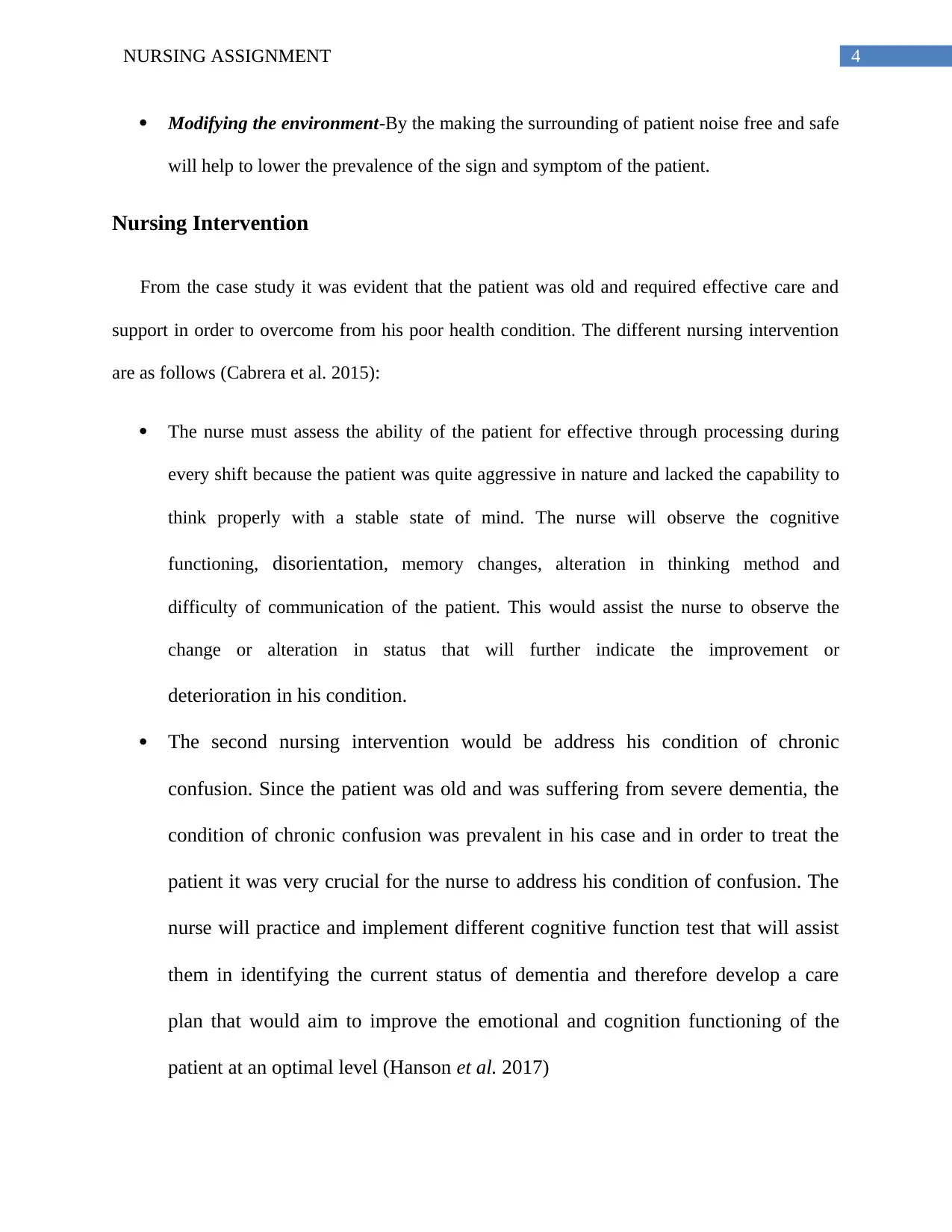
4NURSING ASSIGNMENT
Modifying the environment-By the making the surrounding of patient noise free and safe
will help to lower the prevalence of the sign and symptom of the patient.
Nursing Intervention
From the case study it was evident that the patient was old and required effective care and
support in order to overcome from his poor health condition. The different nursing intervention
are as follows (Cabrera et al. 2015):
The nurse must assess the ability of the patient for effective through processing during
every shift because the patient was quite aggressive in nature and lacked the capability to
think properly with a stable state of mind. The nurse will observe the cognitive
functioning, disorientation, memory changes, alteration in thinking method and
difficulty of communication of the patient. This would assist the nurse to observe the
change or alteration in status that will further indicate the improvement or
deterioration in his condition.
The second nursing intervention would be address his condition of chronic
confusion. Since the patient was old and was suffering from severe dementia, the
condition of chronic confusion was prevalent in his case and in order to treat the
patient it was very crucial for the nurse to address his condition of confusion. The
nurse will practice and implement different cognitive function test that will assist
them in identifying the current status of dementia and therefore develop a care
plan that would aim to improve the emotional and cognition functioning of the
patient at an optimal level (Hanson et al. 2017)
Modifying the environment-By the making the surrounding of patient noise free and safe
will help to lower the prevalence of the sign and symptom of the patient.
Nursing Intervention
From the case study it was evident that the patient was old and required effective care and
support in order to overcome from his poor health condition. The different nursing intervention
are as follows (Cabrera et al. 2015):
The nurse must assess the ability of the patient for effective through processing during
every shift because the patient was quite aggressive in nature and lacked the capability to
think properly with a stable state of mind. The nurse will observe the cognitive
functioning, disorientation, memory changes, alteration in thinking method and
difficulty of communication of the patient. This would assist the nurse to observe the
change or alteration in status that will further indicate the improvement or
deterioration in his condition.
The second nursing intervention would be address his condition of chronic
confusion. Since the patient was old and was suffering from severe dementia, the
condition of chronic confusion was prevalent in his case and in order to treat the
patient it was very crucial for the nurse to address his condition of confusion. The
nurse will practice and implement different cognitive function test that will assist
them in identifying the current status of dementia and therefore develop a care
plan that would aim to improve the emotional and cognition functioning of the
patient at an optimal level (Hanson et al. 2017)
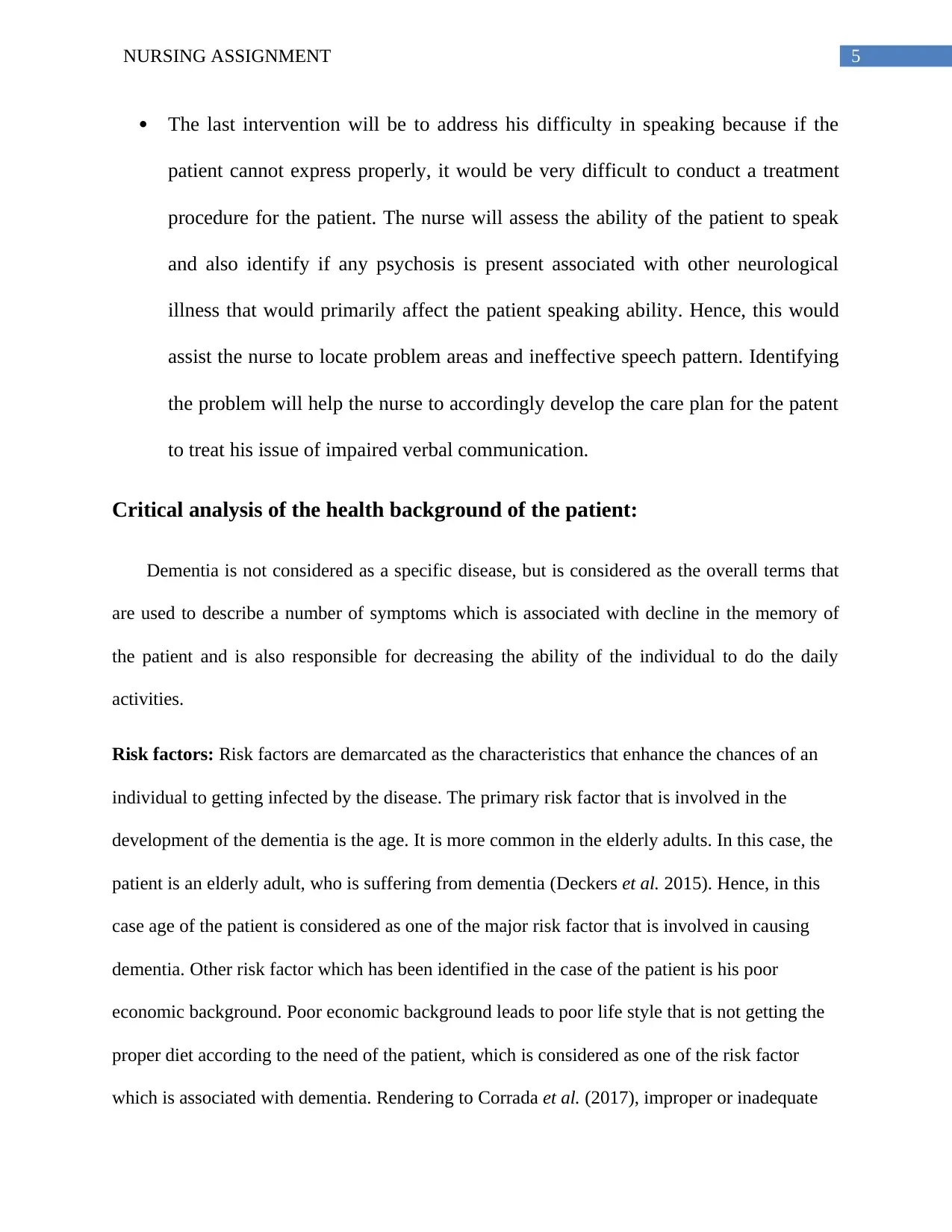
5NURSING ASSIGNMENT
The last intervention will be to address his difficulty in speaking because if the
patient cannot express properly, it would be very difficult to conduct a treatment
procedure for the patient. The nurse will assess the ability of the patient to speak
and also identify if any psychosis is present associated with other neurological
illness that would primarily affect the patient speaking ability. Hence, this would
assist the nurse to locate problem areas and ineffective speech pattern. Identifying
the problem will help the nurse to accordingly develop the care plan for the patent
to treat his issue of impaired verbal communication.
Critical analysis of the health background of the patient:
Dementia is not considered as a specific disease, but is considered as the overall terms that
are used to describe a number of symptoms which is associated with decline in the memory of
the patient and is also responsible for decreasing the ability of the individual to do the daily
activities.
Risk factors: Risk factors are demarcated as the characteristics that enhance the chances of an
individual to getting infected by the disease. The primary risk factor that is involved in the
development of the dementia is the age. It is more common in the elderly adults. In this case, the
patient is an elderly adult, who is suffering from dementia (Deckers et al. 2015). Hence, in this
case age of the patient is considered as one of the major risk factor that is involved in causing
dementia. Other risk factor which has been identified in the case of the patient is his poor
economic background. Poor economic background leads to poor life style that is not getting the
proper diet according to the need of the patient, which is considered as one of the risk factor
which is associated with dementia. Rendering to Corrada et al. (2017), improper or inadequate
The last intervention will be to address his difficulty in speaking because if the
patient cannot express properly, it would be very difficult to conduct a treatment
procedure for the patient. The nurse will assess the ability of the patient to speak
and also identify if any psychosis is present associated with other neurological
illness that would primarily affect the patient speaking ability. Hence, this would
assist the nurse to locate problem areas and ineffective speech pattern. Identifying
the problem will help the nurse to accordingly develop the care plan for the patent
to treat his issue of impaired verbal communication.
Critical analysis of the health background of the patient:
Dementia is not considered as a specific disease, but is considered as the overall terms that
are used to describe a number of symptoms which is associated with decline in the memory of
the patient and is also responsible for decreasing the ability of the individual to do the daily
activities.
Risk factors: Risk factors are demarcated as the characteristics that enhance the chances of an
individual to getting infected by the disease. The primary risk factor that is involved in the
development of the dementia is the age. It is more common in the elderly adults. In this case, the
patient is an elderly adult, who is suffering from dementia (Deckers et al. 2015). Hence, in this
case age of the patient is considered as one of the major risk factor that is involved in causing
dementia. Other risk factor which has been identified in the case of the patient is his poor
economic background. Poor economic background leads to poor life style that is not getting the
proper diet according to the need of the patient, which is considered as one of the risk factor
which is associated with dementia. Rendering to Corrada et al. (2017), improper or inadequate
⊘ This is a preview!⊘
Do you want full access?
Subscribe today to unlock all pages.

Trusted by 1+ million students worldwide
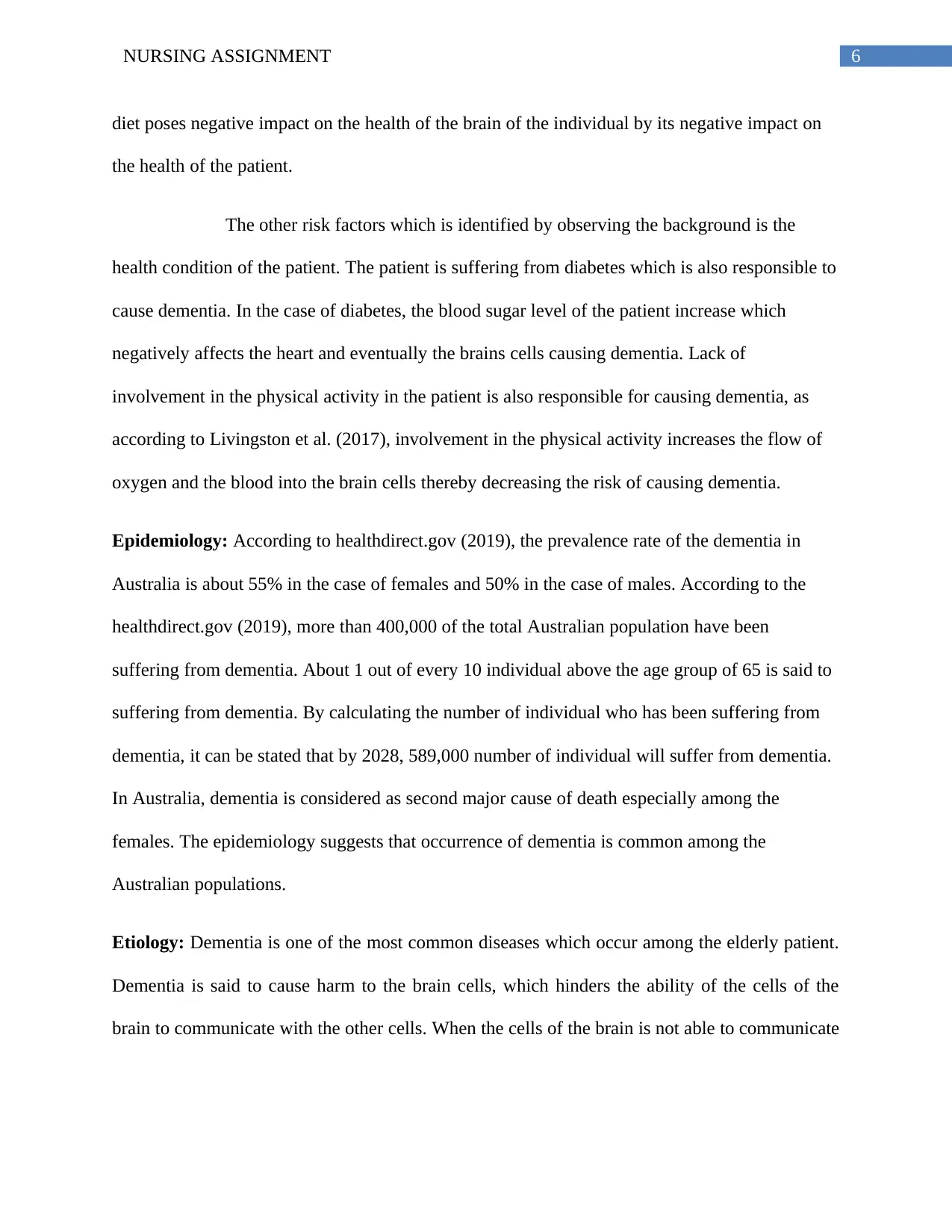
6NURSING ASSIGNMENT
diet poses negative impact on the health of the brain of the individual by its negative impact on
the health of the patient.
The other risk factors which is identified by observing the background is the
health condition of the patient. The patient is suffering from diabetes which is also responsible to
cause dementia. In the case of diabetes, the blood sugar level of the patient increase which
negatively affects the heart and eventually the brains cells causing dementia. Lack of
involvement in the physical activity in the patient is also responsible for causing dementia, as
according to Livingston et al. (2017), involvement in the physical activity increases the flow of
oxygen and the blood into the brain cells thereby decreasing the risk of causing dementia.
Epidemiology: According to healthdirect.gov (2019), the prevalence rate of the dementia in
Australia is about 55% in the case of females and 50% in the case of males. According to the
healthdirect.gov (2019), more than 400,000 of the total Australian population have been
suffering from dementia. About 1 out of every 10 individual above the age group of 65 is said to
suffering from dementia. By calculating the number of individual who has been suffering from
dementia, it can be stated that by 2028, 589,000 number of individual will suffer from dementia.
In Australia, dementia is considered as second major cause of death especially among the
females. The epidemiology suggests that occurrence of dementia is common among the
Australian populations.
Etiology: Dementia is one of the most common diseases which occur among the elderly patient.
Dementia is said to cause harm to the brain cells, which hinders the ability of the cells of the
brain to communicate with the other cells. When the cells of the brain is not able to communicate
diet poses negative impact on the health of the brain of the individual by its negative impact on
the health of the patient.
The other risk factors which is identified by observing the background is the
health condition of the patient. The patient is suffering from diabetes which is also responsible to
cause dementia. In the case of diabetes, the blood sugar level of the patient increase which
negatively affects the heart and eventually the brains cells causing dementia. Lack of
involvement in the physical activity in the patient is also responsible for causing dementia, as
according to Livingston et al. (2017), involvement in the physical activity increases the flow of
oxygen and the blood into the brain cells thereby decreasing the risk of causing dementia.
Epidemiology: According to healthdirect.gov (2019), the prevalence rate of the dementia in
Australia is about 55% in the case of females and 50% in the case of males. According to the
healthdirect.gov (2019), more than 400,000 of the total Australian population have been
suffering from dementia. About 1 out of every 10 individual above the age group of 65 is said to
suffering from dementia. By calculating the number of individual who has been suffering from
dementia, it can be stated that by 2028, 589,000 number of individual will suffer from dementia.
In Australia, dementia is considered as second major cause of death especially among the
females. The epidemiology suggests that occurrence of dementia is common among the
Australian populations.
Etiology: Dementia is one of the most common diseases which occur among the elderly patient.
Dementia is said to cause harm to the brain cells, which hinders the ability of the cells of the
brain to communicate with the other cells. When the cells of the brain is not able to communicate
Paraphrase This Document
Need a fresh take? Get an instant paraphrase of this document with our AI Paraphraser
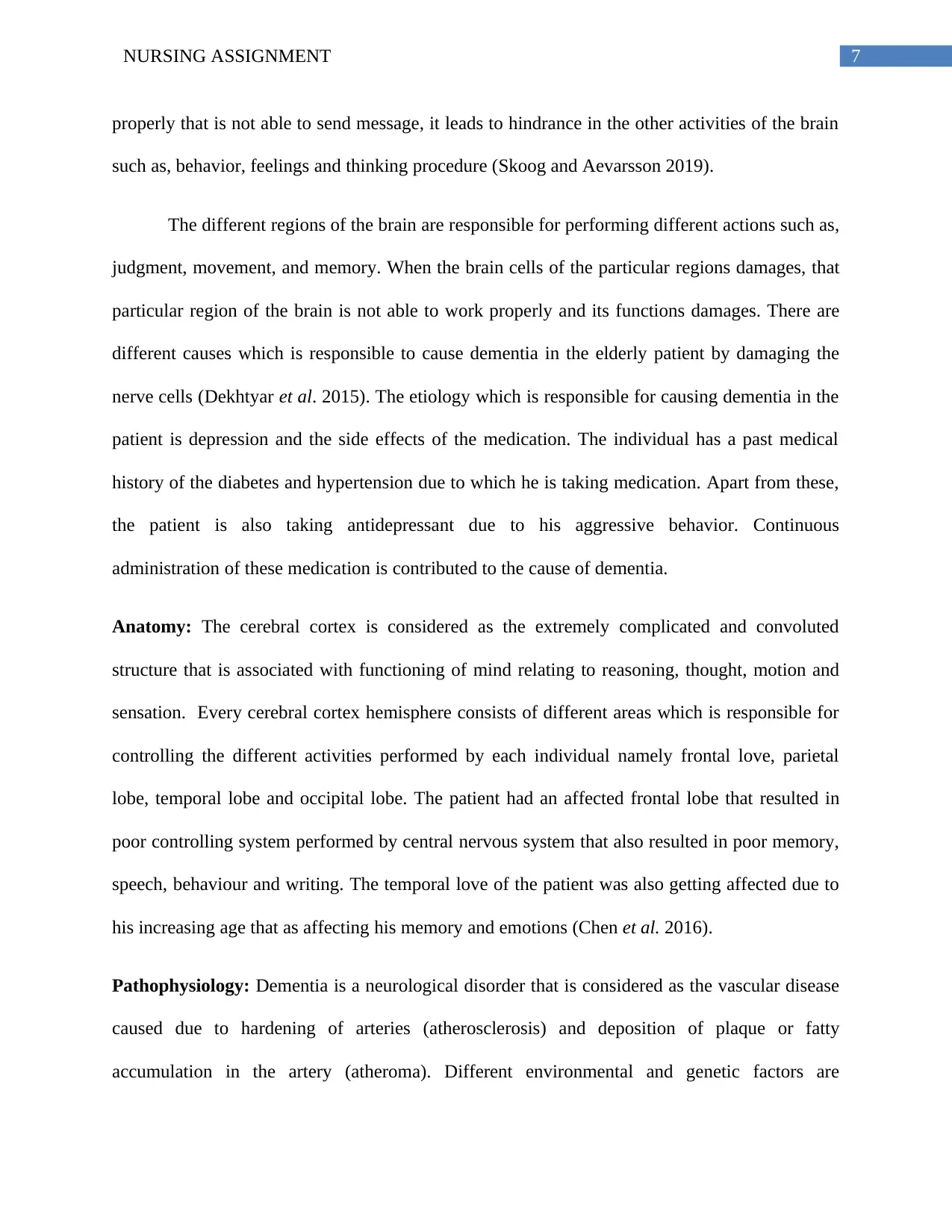
7NURSING ASSIGNMENT
properly that is not able to send message, it leads to hindrance in the other activities of the brain
such as, behavior, feelings and thinking procedure (Skoog and Aevarsson 2019).
The different regions of the brain are responsible for performing different actions such as,
judgment, movement, and memory. When the brain cells of the particular regions damages, that
particular region of the brain is not able to work properly and its functions damages. There are
different causes which is responsible to cause dementia in the elderly patient by damaging the
nerve cells (Dekhtyar et al. 2015). The etiology which is responsible for causing dementia in the
patient is depression and the side effects of the medication. The individual has a past medical
history of the diabetes and hypertension due to which he is taking medication. Apart from these,
the patient is also taking antidepressant due to his aggressive behavior. Continuous
administration of these medication is contributed to the cause of dementia.
Anatomy: The cerebral cortex is considered as the extremely complicated and convoluted
structure that is associated with functioning of mind relating to reasoning, thought, motion and
sensation. Every cerebral cortex hemisphere consists of different areas which is responsible for
controlling the different activities performed by each individual namely frontal love, parietal
lobe, temporal lobe and occipital lobe. The patient had an affected frontal lobe that resulted in
poor controlling system performed by central nervous system that also resulted in poor memory,
speech, behaviour and writing. The temporal love of the patient was also getting affected due to
his increasing age that as affecting his memory and emotions (Chen et al. 2016).
Pathophysiology: Dementia is a neurological disorder that is considered as the vascular disease
caused due to hardening of arteries (atherosclerosis) and deposition of plaque or fatty
accumulation in the artery (atheroma). Different environmental and genetic factors are
properly that is not able to send message, it leads to hindrance in the other activities of the brain
such as, behavior, feelings and thinking procedure (Skoog and Aevarsson 2019).
The different regions of the brain are responsible for performing different actions such as,
judgment, movement, and memory. When the brain cells of the particular regions damages, that
particular region of the brain is not able to work properly and its functions damages. There are
different causes which is responsible to cause dementia in the elderly patient by damaging the
nerve cells (Dekhtyar et al. 2015). The etiology which is responsible for causing dementia in the
patient is depression and the side effects of the medication. The individual has a past medical
history of the diabetes and hypertension due to which he is taking medication. Apart from these,
the patient is also taking antidepressant due to his aggressive behavior. Continuous
administration of these medication is contributed to the cause of dementia.
Anatomy: The cerebral cortex is considered as the extremely complicated and convoluted
structure that is associated with functioning of mind relating to reasoning, thought, motion and
sensation. Every cerebral cortex hemisphere consists of different areas which is responsible for
controlling the different activities performed by each individual namely frontal love, parietal
lobe, temporal lobe and occipital lobe. The patient had an affected frontal lobe that resulted in
poor controlling system performed by central nervous system that also resulted in poor memory,
speech, behaviour and writing. The temporal love of the patient was also getting affected due to
his increasing age that as affecting his memory and emotions (Chen et al. 2016).
Pathophysiology: Dementia is a neurological disorder that is considered as the vascular disease
caused due to hardening of arteries (atherosclerosis) and deposition of plaque or fatty
accumulation in the artery (atheroma). Different environmental and genetic factors are
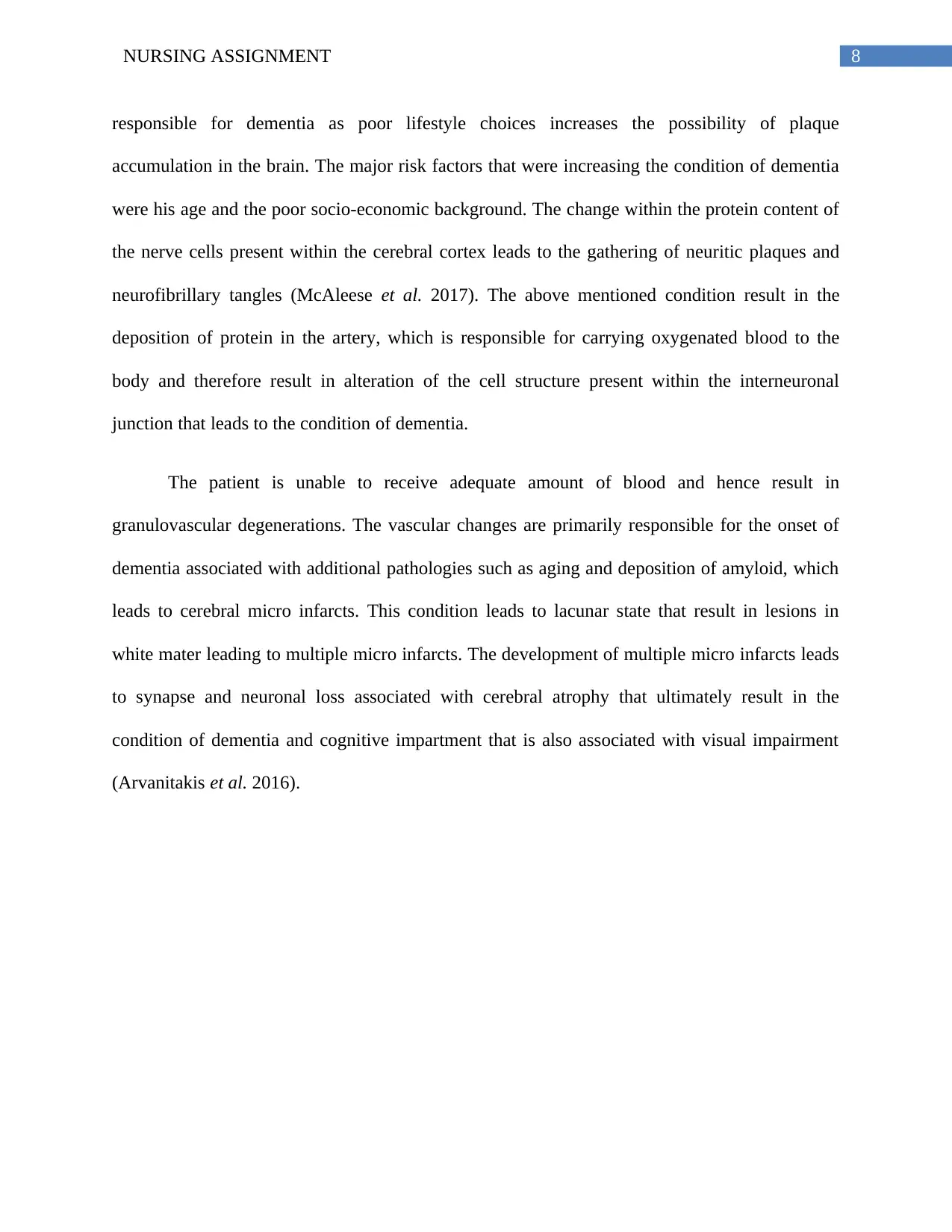
8NURSING ASSIGNMENT
responsible for dementia as poor lifestyle choices increases the possibility of plaque
accumulation in the brain. The major risk factors that were increasing the condition of dementia
were his age and the poor socio-economic background. The change within the protein content of
the nerve cells present within the cerebral cortex leads to the gathering of neuritic plaques and
neurofibrillary tangles (McAleese et al. 2017). The above mentioned condition result in the
deposition of protein in the artery, which is responsible for carrying oxygenated blood to the
body and therefore result in alteration of the cell structure present within the interneuronal
junction that leads to the condition of dementia.
The patient is unable to receive adequate amount of blood and hence result in
granulovascular degenerations. The vascular changes are primarily responsible for the onset of
dementia associated with additional pathologies such as aging and deposition of amyloid, which
leads to cerebral micro infarcts. This condition leads to lacunar state that result in lesions in
white mater leading to multiple micro infarcts. The development of multiple micro infarcts leads
to synapse and neuronal loss associated with cerebral atrophy that ultimately result in the
condition of dementia and cognitive impartment that is also associated with visual impairment
(Arvanitakis et al. 2016).
responsible for dementia as poor lifestyle choices increases the possibility of plaque
accumulation in the brain. The major risk factors that were increasing the condition of dementia
were his age and the poor socio-economic background. The change within the protein content of
the nerve cells present within the cerebral cortex leads to the gathering of neuritic plaques and
neurofibrillary tangles (McAleese et al. 2017). The above mentioned condition result in the
deposition of protein in the artery, which is responsible for carrying oxygenated blood to the
body and therefore result in alteration of the cell structure present within the interneuronal
junction that leads to the condition of dementia.
The patient is unable to receive adequate amount of blood and hence result in
granulovascular degenerations. The vascular changes are primarily responsible for the onset of
dementia associated with additional pathologies such as aging and deposition of amyloid, which
leads to cerebral micro infarcts. This condition leads to lacunar state that result in lesions in
white mater leading to multiple micro infarcts. The development of multiple micro infarcts leads
to synapse and neuronal loss associated with cerebral atrophy that ultimately result in the
condition of dementia and cognitive impartment that is also associated with visual impairment
(Arvanitakis et al. 2016).
⊘ This is a preview!⊘
Do you want full access?
Subscribe today to unlock all pages.

Trusted by 1+ million students worldwide

9NURSING ASSIGNMENT
References:
Arevalo‐Rodriguez, I., Smailagic, N., i Figuls, M.R., Ciapponi, A., Sanchez‐Perez, E.,
Giannakou, A., Pedraza, O.L., Cosp, X.B. and Cullum, S., 2015. Mini‐Mental State Examination
(MMSE) for the detection of Alzheimer's disease and other dementias in people with mild
cognitive impairment (MCI). Cochrane Database of Systematic Reviews, (3).
Arvanitakis, Z., Capuano, A.W., Leurgans, S.E., Bennett, D.A. and Schneider, J.A., 2016.
Relation of cerebral vessel disease to Alzheimer's disease dementia and cognitive function in
elderly people: a cross-sectional study. The Lancet Neurology, 15(9), pp.934-943.
Cabrera, E., Sutcliffe, C., Verbeek, H., Saks, K., Soto-Martin, M., Meyer, G., Leino-Kilpi, H.,
Karlsson, S., Zabalegui, A. and RightTimePlaceCare Consortium, 2015. Non-pharmacological
interventions as a best practice strategy in people with dementia living in nursing homes. A
systematic review. European Geriatric Medicine, 6(2), pp.134-150.
Chen, F.X., Kang, D.Z., Chen, F.Y., Liu, Y., Wu, G., Li, X., Yu, L.H., Lin, Y.X. and Lin, Z.Y.,
2016. Gray matter atrophy associated with mild cognitive impairment in Parkinson’s
disease. Neuroscience letters, 617, pp.160-165.
Corrada, M.M., Hayden, K.M., Paganini-Hill, A., Bullain, S.S., DeMoss, J., Aguirre, C.,
Brookmeyer, R. and Kawas, C.H., 2017. Age of onset of hypertension and risk of dementia in
the oldest-old: The 90+ Study. Alzheimer's & Dementia, 13(2), pp.103-110.
Deckers, K., van Boxtel, M.P., Schiepers, O.J., de Vugt, M., Munoz Sanchez, J.L., Anstey, K.J.,
Brayne, C., Dartigues, J.F., Engedal, K., Kivipelto, M. and Ritchie, K., 2015. Target risk factors
References:
Arevalo‐Rodriguez, I., Smailagic, N., i Figuls, M.R., Ciapponi, A., Sanchez‐Perez, E.,
Giannakou, A., Pedraza, O.L., Cosp, X.B. and Cullum, S., 2015. Mini‐Mental State Examination
(MMSE) for the detection of Alzheimer's disease and other dementias in people with mild
cognitive impairment (MCI). Cochrane Database of Systematic Reviews, (3).
Arvanitakis, Z., Capuano, A.W., Leurgans, S.E., Bennett, D.A. and Schneider, J.A., 2016.
Relation of cerebral vessel disease to Alzheimer's disease dementia and cognitive function in
elderly people: a cross-sectional study. The Lancet Neurology, 15(9), pp.934-943.
Cabrera, E., Sutcliffe, C., Verbeek, H., Saks, K., Soto-Martin, M., Meyer, G., Leino-Kilpi, H.,
Karlsson, S., Zabalegui, A. and RightTimePlaceCare Consortium, 2015. Non-pharmacological
interventions as a best practice strategy in people with dementia living in nursing homes. A
systematic review. European Geriatric Medicine, 6(2), pp.134-150.
Chen, F.X., Kang, D.Z., Chen, F.Y., Liu, Y., Wu, G., Li, X., Yu, L.H., Lin, Y.X. and Lin, Z.Y.,
2016. Gray matter atrophy associated with mild cognitive impairment in Parkinson’s
disease. Neuroscience letters, 617, pp.160-165.
Corrada, M.M., Hayden, K.M., Paganini-Hill, A., Bullain, S.S., DeMoss, J., Aguirre, C.,
Brookmeyer, R. and Kawas, C.H., 2017. Age of onset of hypertension and risk of dementia in
the oldest-old: The 90+ Study. Alzheimer's & Dementia, 13(2), pp.103-110.
Deckers, K., van Boxtel, M.P., Schiepers, O.J., de Vugt, M., Munoz Sanchez, J.L., Anstey, K.J.,
Brayne, C., Dartigues, J.F., Engedal, K., Kivipelto, M. and Ritchie, K., 2015. Target risk factors
Paraphrase This Document
Need a fresh take? Get an instant paraphrase of this document with our AI Paraphraser

10NURSING ASSIGNMENT
for dementia prevention: a systematic review and Delphi consensus study on the evidence from
observational studies. International journal of geriatric psychiatry, 30(3), pp.234-246.
Dekhtyar, S., Wang, H.X., Scott, K., Goodman, A., Koupil, I. and Herlitz, A., 2015. A life-
course study of cognitive reserve in dementia—from childhood to old age. The American journal
of geriatric psychiatry, 23(9), pp.885-896.
Donaghy, P.C., Taylor, J.P., T O'Brien, J., Barnett, N., Olsen, K., Colloby, S.J., Lloyd, J.,
Petrides, G., McKeith, I.G. and Thomas, A.J., 2018. Neuropsychiatric symptoms and cognitive
profile in mild cognitive impairment with Lewy bodies. Psychological medicine, 48(14),
pp.2384-2390.
Hanson, L.C., Zimmerman, S., Song, M.K., Lin, F.C., Rosemond, C., Carey, T.S. and Mitchell,
S.L., 2017. Effect of the goals of care intervention for advanced dementia: a randomized clinical
trial. JAMA internal medicine, 177(1), pp.24-31.
Healthdirect.gov (2019). Dementia statistics. [online] Healthdirect.gov.au. Available at:
https://www.healthdirect.gov.au/dementia-statistics [Accessed 25 Aug. 2019].
Kratz, T., 2017. The diagnosis and treatment of behavioral disorders in dementia. Deutsches
Ärzteblatt International, 114(26), p.447.
Livingston, G., Sommerlad, A., Orgeta, V., Costafreda, S.G., Huntley, J., Ames, D., Ballard, C.,
Banerjee, S., Burns, A., Cohen-Mansfield, J. and Cooper, C., 2017. Dementia prevention,
intervention, and care. The Lancet, 390(10113), pp.2673-2734.
for dementia prevention: a systematic review and Delphi consensus study on the evidence from
observational studies. International journal of geriatric psychiatry, 30(3), pp.234-246.
Dekhtyar, S., Wang, H.X., Scott, K., Goodman, A., Koupil, I. and Herlitz, A., 2015. A life-
course study of cognitive reserve in dementia—from childhood to old age. The American journal
of geriatric psychiatry, 23(9), pp.885-896.
Donaghy, P.C., Taylor, J.P., T O'Brien, J., Barnett, N., Olsen, K., Colloby, S.J., Lloyd, J.,
Petrides, G., McKeith, I.G. and Thomas, A.J., 2018. Neuropsychiatric symptoms and cognitive
profile in mild cognitive impairment with Lewy bodies. Psychological medicine, 48(14),
pp.2384-2390.
Hanson, L.C., Zimmerman, S., Song, M.K., Lin, F.C., Rosemond, C., Carey, T.S. and Mitchell,
S.L., 2017. Effect of the goals of care intervention for advanced dementia: a randomized clinical
trial. JAMA internal medicine, 177(1), pp.24-31.
Healthdirect.gov (2019). Dementia statistics. [online] Healthdirect.gov.au. Available at:
https://www.healthdirect.gov.au/dementia-statistics [Accessed 25 Aug. 2019].
Kratz, T., 2017. The diagnosis and treatment of behavioral disorders in dementia. Deutsches
Ärzteblatt International, 114(26), p.447.
Livingston, G., Sommerlad, A., Orgeta, V., Costafreda, S.G., Huntley, J., Ames, D., Ballard, C.,
Banerjee, S., Burns, A., Cohen-Mansfield, J. and Cooper, C., 2017. Dementia prevention,
intervention, and care. The Lancet, 390(10113), pp.2673-2734.
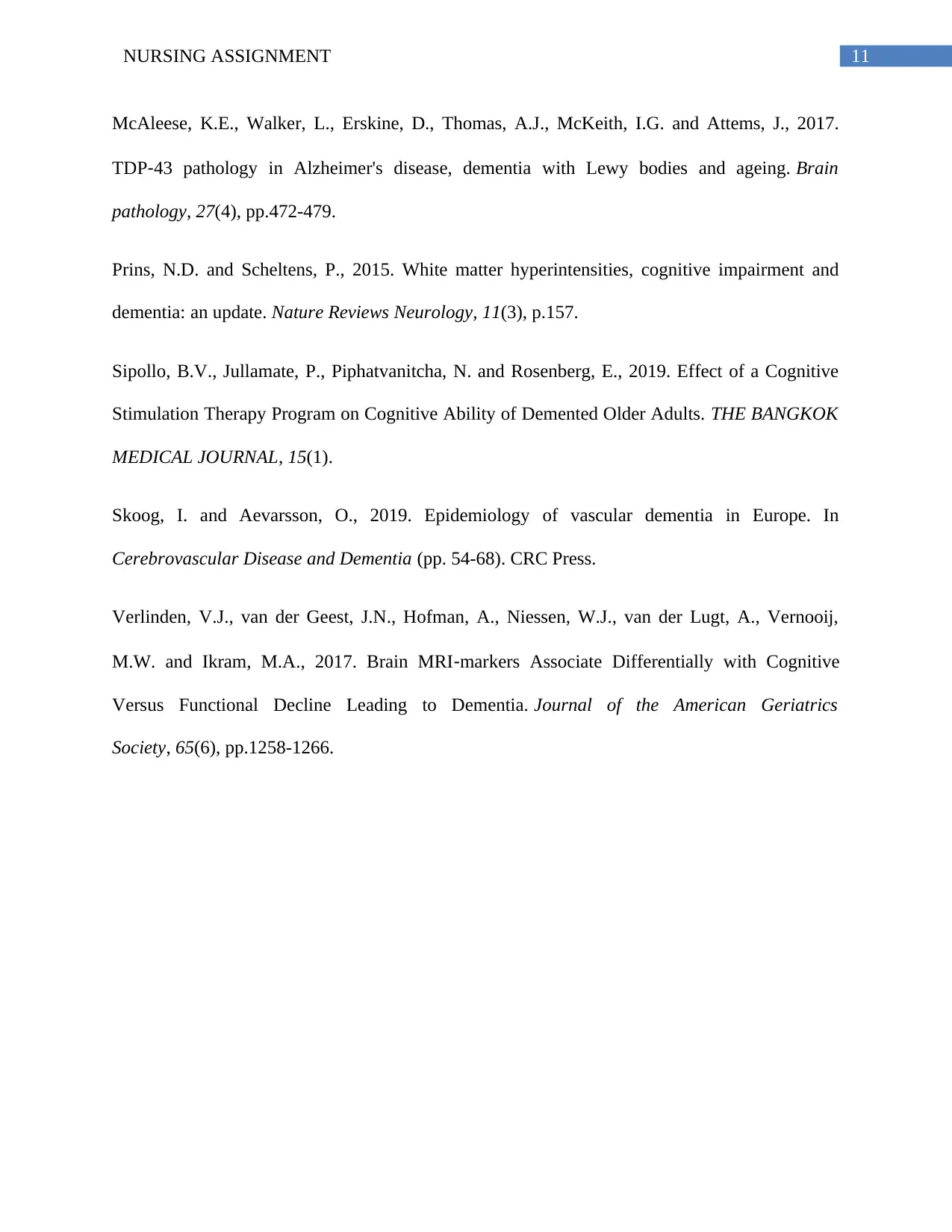
11NURSING ASSIGNMENT
McAleese, K.E., Walker, L., Erskine, D., Thomas, A.J., McKeith, I.G. and Attems, J., 2017.
TDP‐43 pathology in Alzheimer's disease, dementia with Lewy bodies and ageing. Brain
pathology, 27(4), pp.472-479.
Prins, N.D. and Scheltens, P., 2015. White matter hyperintensities, cognitive impairment and
dementia: an update. Nature Reviews Neurology, 11(3), p.157.
Sipollo, B.V., Jullamate, P., Piphatvanitcha, N. and Rosenberg, E., 2019. Effect of a Cognitive
Stimulation Therapy Program on Cognitive Ability of Demented Older Adults. THE BANGKOK
MEDICAL JOURNAL, 15(1).
Skoog, I. and Aevarsson, O., 2019. Epidemiology of vascular dementia in Europe. In
Cerebrovascular Disease and Dementia (pp. 54-68). CRC Press.
Verlinden, V.J., van der Geest, J.N., Hofman, A., Niessen, W.J., van der Lugt, A., Vernooij,
M.W. and Ikram, M.A., 2017. Brain MRI‐markers Associate Differentially with Cognitive
Versus Functional Decline Leading to Dementia. Journal of the American Geriatrics
Society, 65(6), pp.1258-1266.
McAleese, K.E., Walker, L., Erskine, D., Thomas, A.J., McKeith, I.G. and Attems, J., 2017.
TDP‐43 pathology in Alzheimer's disease, dementia with Lewy bodies and ageing. Brain
pathology, 27(4), pp.472-479.
Prins, N.D. and Scheltens, P., 2015. White matter hyperintensities, cognitive impairment and
dementia: an update. Nature Reviews Neurology, 11(3), p.157.
Sipollo, B.V., Jullamate, P., Piphatvanitcha, N. and Rosenberg, E., 2019. Effect of a Cognitive
Stimulation Therapy Program on Cognitive Ability of Demented Older Adults. THE BANGKOK
MEDICAL JOURNAL, 15(1).
Skoog, I. and Aevarsson, O., 2019. Epidemiology of vascular dementia in Europe. In
Cerebrovascular Disease and Dementia (pp. 54-68). CRC Press.
Verlinden, V.J., van der Geest, J.N., Hofman, A., Niessen, W.J., van der Lugt, A., Vernooij,
M.W. and Ikram, M.A., 2017. Brain MRI‐markers Associate Differentially with Cognitive
Versus Functional Decline Leading to Dementia. Journal of the American Geriatrics
Society, 65(6), pp.1258-1266.
⊘ This is a preview!⊘
Do you want full access?
Subscribe today to unlock all pages.

Trusted by 1+ million students worldwide
1 out of 12
Related Documents
Your All-in-One AI-Powered Toolkit for Academic Success.
+13062052269
info@desklib.com
Available 24*7 on WhatsApp / Email
![[object Object]](/_next/static/media/star-bottom.7253800d.svg)
Unlock your academic potential
Copyright © 2020–2025 A2Z Services. All Rights Reserved. Developed and managed by ZUCOL.





